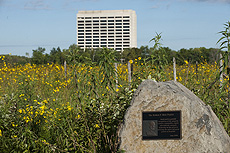Economics of the ecological
 |
| The Robert F. Betz Prairie in the middle of the Main Ring provides not only a great view but also services such as carbon sequestration and stormwater retention. Photo: Reidar Hahn |
There are many ways to think about how valuable nature is to us. Most of us like to go out and appreciate the natural surroundings, looking at trees, spring flowers and birds. The aesthetic and spiritual value of nature is something we take for granted most of the time. But sometimes it is useful to think about nature in more quantifiable terms. It is commonplace to put economic measures on natural phenomena like floods, storms earthquakes and fires. It is relatively easy to come to the "negative value" of such events by adding up the cost of rebuilding or replacing.
It is likewise possible to evaluate the positive aspects of nature — often referred to as ecosystem services — by determining the economic value to humans of wild nature. Perhaps the most familiar ecosystem service is insect pollination. Not only honeybees but also lots of other insects pollinate plants, including crops, inadvertently, in insects' search for nectar. For an orchard owner, that service can be incredibly valuable, essentially accounting for the cash value of the entire crop!
Other animals, including insects, prey on plant pests, reducing the need for larger amounts of pesticide, thereby decreasing the cost of raising the crop. Here at Fermilab the coyote population has a large impact on rodents, groundhogs and Canada geese, all of which can cause problems when their populations are unchecked.
Other services may not be directly related to crop production. Wetlands function to retain stormwater, sort of as a sponge, before releasing it slowly downstream. They also play an important role in cleansing water that may have become polluted by human activity. These services would be extremely expensive if we had to design and build new retention structures and water treatment plants. With available ecosystem services, we can avoid those costs. It has been estimated that the annual worldwide value of these services is over $1 trillion.
Even the restored prairie can be valuable to us by capturing atmospheric carbon and transporting it to the deep roots of the plants and from there to complex chemicals underground, effectively sequestering extra carbon from burning fossil fuels.
This economic way of thinking is itself valuable if we keep in mind that whether we enjoy birdwatching or a prairie walk, these natural ecosystems are valuable to us in much more tangible ways.
—Rod Walton
|